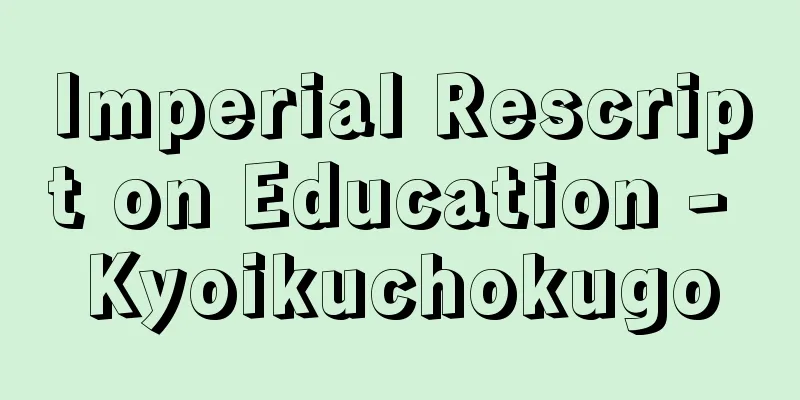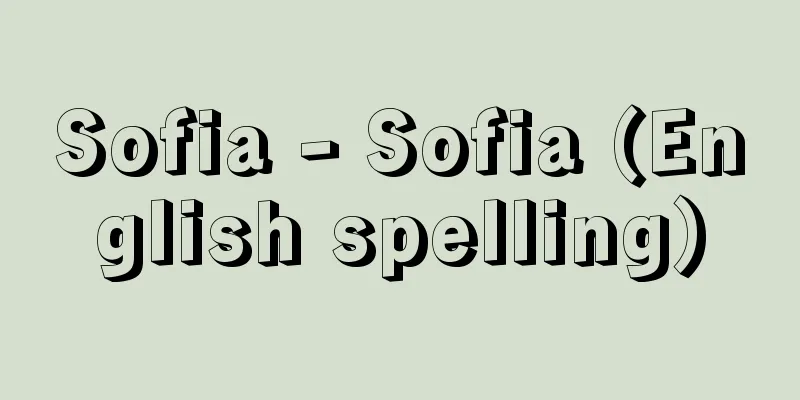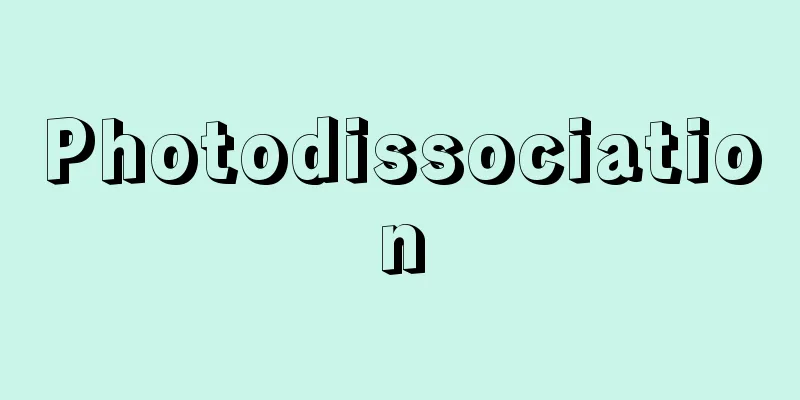Imperial Rescript on Education - Kyoikuchokugo

|
An Imperial Rescript that outlines the ideology of the imperial state and the basic principles of education. It is also called the Imperial Rescript on Education. It was issued on October 30, 1890 (Meiji 23). Its predecessor was a movement to strengthen moral education from a traditionalist and Confucianist standpoint by a group of close associates of the emperor who opposed the Freedom and People's Rights Movement and the Ministry of Education's Westernization policy, such as the drafting of the "Imperial Instructions on Education" (1879) and the distribution of the "Outline of Early Childhood Education" (1882). The direct impetus for its establishment was a proposal made by a meeting of local governors in February 1890 to the cabinet urging it to establish principles for moral education. The cabinet of Yamagata Aritomo, who was then the Minister of Education, accepted this proposal and began full-scale drafting at the order of the emperor to Yoshikawa Akimasa to compile a collection of proverbs. The editing work was initially entrusted to Nakamura Masanao, but later passed to Inoue Kowashi, Director-General of the Legislative Bureau, with the cooperation of Motoda Nagazane, Privy Councilor. The entire text is 315 characters long. The first section explains that the emperor's virtue and the loyalty of the people are the "essence of the national polity" and at the same time the "origin of education." The second section lists 14 virtues, including "filial piety to parents... (omitted)... and shall support the imperial fortunes of the emperor that will last forever." The third section states that these virtues originate from the "teachings of our imperial ancestors" and have universal validity that should be observed forever. To distinguish it from general political edicts, it did not have a ministerial affix. After it was issued, copies were made by the Ministry of Education and distributed to schools throughout the country. It was read aloud at school ceremonies and other events, and had overwhelming authority as the absolute standard of national morality and the highest principle of educational activities, and the content of various subjects, including ethics, was regulated by it. It was extremely sanctified, especially during the Fifteen Years' War. Many commentaries on it have been published, such as Tetsujiro Inoue's "Engi" (1891). As a result of postwar political reforms, in October 1946, the reading of the Imperial Rescript on Education and the deification of the Emperor were prohibited, and on June 19, 1948, both the House of Representatives and the House of Councillors passed resolutions to abolish the Imperial Rescript on Education and to confirm its invalidity, respectively, on the grounds that it violated the spirit of the Constitution and the Fundamental Law of Education. The copies were recalled and disposed of. However, even after that, there were persistent voices defending the Imperial Rescript on Education, such as the statement by then Minister of Education Amano Teiyu in defense of the Rescript (1950) and the statement by Prime Minister Tanaka Kakuei about the universality of the virtues of the Rescript (1974). In connection with the movement to reexamine the postwar Emperor System, including constitutional reform, there is an ongoing movement to reevaluate the Imperial Rescript on Education among some politicians and business leaders, scholars, cultural figures, and those connected to shrines. [Ozaki Mugen] "Collection of Materials Related to the Promulgation of the Imperial Rescript on Education, 3 volumes (1938, National Institute for Cultural Heritage)" ▽ "A Study of the History of the Establishment of the Imperial Rescript on Education, by Kaigo Muneomi (1965, University of Tokyo Press)" ▽ "The Imperial Rescript on Education and School Education: The Role It Played in Thought Control, by Takashima Nobuyoshi (1990, Iwanami Shoten)" ▽ "The Imperial Rescript on Education, Commentary by Ohara Yasuo ( 1996, Life Publishing)" ▽ "Do You Know the Imperial Rescript on Education? Memories of the 'Land of the Gods,' by Tsuda Michio (2000, Shakai Hyoronsha)" ▽ "A Study of the Imperial Rescript on Education, by Iwamoto Tsutomu (2001, Minshusha)" [Reference items] | | Meet| | |©Shogakukan "> Imperial Rescript on Education (full text) Source: Shogakukan Encyclopedia Nipponica About Encyclopedia Nipponica Information | Legend |
|
天皇制国家の思想、教育の基本理念を示した勅語。教育に関する勅語ともいう。1890年(明治23)10月30日発布。「教学聖旨(きょうがくせいし)」の起草(1879)や「幼学綱要(ようがくこうよう)」の頒布(1882)など、自由民権運動や文部省の欧化政策に反対する天皇側近グループの伝統主義的、儒教主義的立場からの徳育強化運動が前史としてある。1890年2月の地方長官会議が内閣に対して徳育原則の確立を迫る建議を行ったのが成立の直接の契機である。時の山県有朋(やまがたありとも)内閣はこの建議を受け止め、文部大臣芳川顕正(よしかわあきまさ)に対する天皇の箴言(しんげん)編集の命によって本格的な起草に着手。編集作業は初め中村正直に委嘱されたが、のち法制局長官井上毅(こわし)の手に移り、枢密顧問官元田永孚(もとだながざね)がこれに協力するという形で進行した。全文315字。天皇の有徳と臣民の忠誠が「国体ノ精華(せいか)」であり、同時に「教育ノ淵源(えんげん)」であると説いた第1段、「父母ニ孝ニ……(中略)……天壌無窮(てんじょうむきゅう)ノ皇運ヲ扶翼(ふよく)スヘシ」と、14の徳目を示した第2段、これらの徳は「皇祖皇宗(こうそこうそう)ノ遺訓」に発し永遠に遵守さるべき普遍妥当性をもつと述べた第3段からなる。政治上の一般詔勅と区別するため大臣副書を欠いた。発布後、文部省の手で謄本がつくられ、全国の学校に配布。学校儀式などで奉読され、国民道徳の絶対的基準、教育活動の最高の原理として圧倒的権威をもち、修身科をはじめ諸教科の内容はこれによって規制された。とくに十五年戦争時には極端に神聖化された。井上哲次郎の『勅語衍義(えんぎ)』(1891)など多くの解説書が刊行されている。 戦後政治改革により1946年(昭和21)10月、奉読と神格的取扱いが禁止され、1948年6月19日には衆参両院で、憲法、教育基本法などの法の精神にもとるとして、それぞれ排除、失効確認決議。謄本は回収、処分された。しかしその後も、当時の文部大臣天野貞祐(ていゆう)の教育勅語擁護発言(1950)、首相田中角栄の勅語徳目の普遍性発言(1974)など、教育勅語を擁護する声は根強く、憲法改正を含む戦後天皇制再検討の動きとの関連で、一部政・財界人、学者・文化人、神社関係者などの間では教育勅語を再評価する動きが続いている。 [尾崎ムゲン] 『『教育勅語渙発関係資料集』全3巻(1938・国民精神文化研究所)』▽『海後宗臣著『教育勅語成立史の研究』(1965・東京大学出版会)』▽『高嶋伸欣著『教育勅語と学校教育――思想統制に果たした役割』(1990・岩波書店)』▽『大原康男解説『教育勅語』(1996・ライフ社)』▽『津田道夫著『君は教育勅語を知っているか――「神の国」の記憶』(2000・社会評論社)』▽『岩本努著『教育勅語の研究』(2001・民衆社)』 [参照項目] | | | | |©Shogakukan"> 教育勅語(全文) 出典 小学館 日本大百科全書(ニッポニカ)日本大百科全書(ニッポニカ)について 情報 | 凡例 |
<<: Philosophy of education - English
>>: Educational Counseling - Educational Counseling
Recommend
Banquetting House
…Since the 13th century, it had been the residenc...
Myzopodidae
...A mammal of the Myzopodidae family (one genus,...
ACV - Ace Vee
《 air-cushion vehicle 》A hovercraft. Source: About...
Wall mirror - Kabekagami
…Glass mirrors made from a compound of tin and me...
Kigali - Kigali (English spelling)
The capital of Rwanda, in central Africa. Populat...
Petrosavia sakuraii (Makino) JJ Smith (= Protolirion sakuraii (Makino) Dandy)
A perennial plant of the lily family that rarely g...
Deformed steel bar - Ikeiboko
A type of steel bar, with uneven nodes of various...
Australian Council of Trade Unions - Australian Council of Trade Unions
...However, the shady circumstances of the govern...
Yorktown (aircraft carrier)
…However, with the rapid development of aircraft,...
Hippalos
…In the 10th century BC, the Yemeni kingdom of Sa...
Buzzard (Japanese buzzard)
A bird of the order Accipitridae. It breeds in the...
Oton [1st generation] - Father
…King of Greece. Also called Othon. Reigned 1832-...
sulfur dichloride
...Three types are known. [Disulfur dichloride] T...
Ootobu - Ootobu
(Aogashima Village, Tokyo) A tourist attraction de...
Kaya no Migai - Kaya no Migai
...Because they are abundant, they are used as ma...



![Ina [village] - Ina](/upload/images/67caef7e81780.webp)

![Iya [Hot Springs] - Iya](/upload/images/67cf720b7b282.webp)



